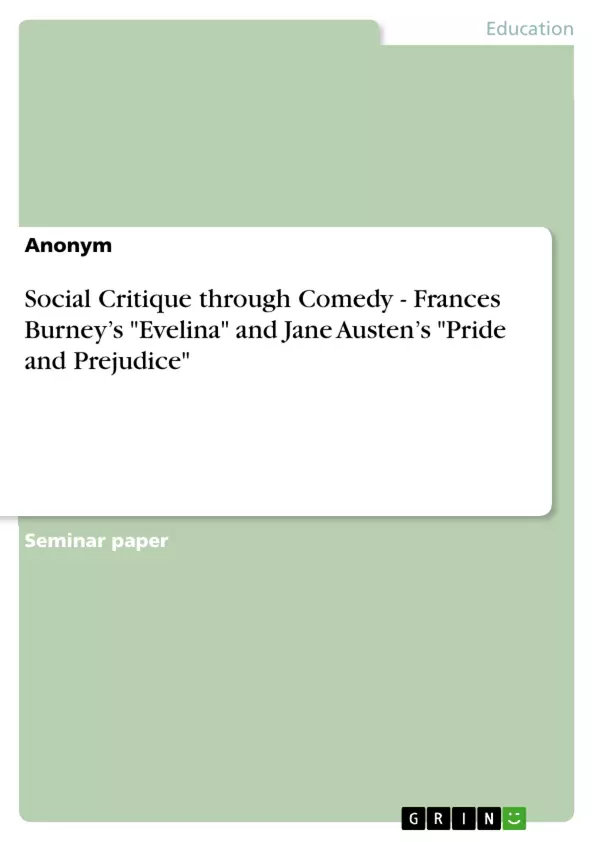This essay is intended to compare both novels regarding their attempt to criticize patriarchy and conducts of the time by sometimes more and sometimes less obvious means of comedy. It shall be discussed, how both writers gain the attention of the audience towards social critique through their narrative techniques as well as through means of characterization. It is to find that although the narrative styles, as well as the stories, seem different, there are certain features which appear similar or create a similar effect and are used in order to call attention to the civilian inequality between men and women.
Table of Contents
- Introduction
- Narrative Techniques
- Stereotypes as means of social critique
- Tricksters as means of social critique
- Mouthpieces for the heroine
- Conclusion
Objectives and Key Themes
This essay compares Frances Burney's Evelina and Jane Austen's Pride and Prejudice, examining how both novels utilize comedy to critique the patriarchal society and social norms of their time. The essay explores the writers' narrative techniques and characterizations to understand how they draw the reader's attention towards social critique. It will demonstrate that while the narrative styles and stories may differ, certain shared features contribute to a similar effect, ultimately highlighting the inequality between men and women in society.
- Social Critique Through Comedy
- Patriarchal Society and Social Norms
- Narrative Techniques and Characterization
- Inequality Between Men and Women
- Comparison of Evelina and Pride and Prejudice
Chapter Summaries
The first chapter introduces the context of 18th and 19th century England, highlighting the limitations placed upon women, particularly middle-class women. The Victorian ideal of the submissive and devoted "Angel in the House" is presented, but also the rise of female authors who began to critique these societal constraints through their writing.
The second chapter focuses on the distinct narrative techniques employed by Burney and Austen. Burney's epistolary style, with its first-person narrator, allows for deep insights into Evelina's thoughts and feelings. This method further legitimized the novel's presentation as a conduct book, appealing to the notion of letter writing as a female activity. Austen's third-person narrative offers a different perspective, providing a more comprehensive view of the Bennet family's social interactions.
The chapter continues to explore the use of satirical elements in both novels, focusing on Burney's technique of adapting the social language of her characters to expose their hypocrisy and foolishness. The chapter highlights how Burney's use of dialogue and the narrator's subtle observations serve to create a satirical portrait of the characters and their social environment.
Keywords
This essay focuses on themes of gender, genre, social critique, comedy, narrative techniques, and characterization. The study primarily explores two novels: Frances Burney's Evelina and Jane Austen's Pride and Prejudice, highlighting their common themes of patriarchal society, the limitations placed upon women, and the use of humor to expose social inequality. Other important terms include conduct books, epistolary style, tricksters, and the "Angel in the House" ideal.
- Quote paper
- Anonym (Author), 2009, Social Critique through Comedy - Frances Burney’s "Evelina" and Jane Austen’s "Pride and Prejudice", Munich, GRIN Verlag, https://www.grin.com/document/201798



